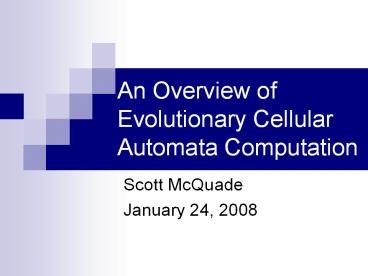An Overview of Evolutionary Cellular Automata Computation - PowerPoint PPT Presentation
Title:
An Overview of Evolutionary Cellular Automata Computation
Description:
One-Dimensional Cellular Automata (Mitchell, Crutchfield, and Das, 1998) ... Results of Selected Rules (Crutchfield and Mitchell, 1995) ... – PowerPoint PPT presentation
Number of Views:147
Avg rating:3.0/5.0
Title: An Overview of Evolutionary Cellular Automata Computation
1
An Overview of Evolutionary Cellular Automata
Computation
- Scott McQuade
- January 24, 2008
2
A2 Papers
- J.P.Crutchfield and M.Mitchell. The evolution of
emergent computation. PNAS, 92 (23) 10742, 1995.
- M.Mitchell, J.P.Crutchfield and R.Das. Evolving
cellular automata to perform computations. In T.
Back, D. Fogel, and Z. Michalewicz (editors),
Handbook of Evolutionary Computation. Oxford
Oxford University Press, 1998.
3
Outline
- Objectives
- Methodology
- Results
- Interpretation of Results
4
Objectives
- Study the evolution and emergence of spatially
extended, decentralized computing - Occurs naturally (insect nests, aggregation of
slime mold, parallel processing by sensory
neurons, economical markets/pricing) (Crutchfield
and Mitchell, 1995) - Applications to computations systems
- Parallel Processing
- Lack of Central Processor
- More Efficient Communications
5
One-Dimensional Cellular Automata (Mitchell,
Crutchfield, and Das, 1998)
6
Example Results (Mitchell, Crutchfield, and Das,
1998)
7
The Task
- Density Classification
- If the initial configuration contains more 1s
than 0s, all cells should eventually switch to
1s - If the initial configuration contains more 0s
than 1s, all cells should eventually switch to
0s - This is referred to as the ?c(1/2) Task
- ?0 refers to the density of 1s in the initial
configuration
8
The Task
- No Cellular Automata can perform the ?c(1/2)
task perfectly across for all N - Even for fixed N, a single cell, or a linear
combination of cells, does not have the
computation power to perform the ?c(1/2) task
well
9
Task Parameters
- N 149
- r 3
- 27 128 bit rule string 2128 possible rules
- ?0 was uniformly distributed between 0 and 1 for
the test cases - NOT the unbiased distribution as it was too
difficult - Maximum Time of 2N to produce the correct
behavior
10
Basics of Genetic Algorithms
- Initial pool of algorithms or strategies
- Run all algorithms Obtain results
- Fitness Function to evaluate the results of
each existing algorithm - Reproduction using the top performing algorithms
recombination (crossover) and mutation - Repeat for multiple generations
11
GA Parameters
- The rules of the automaton will evolve, not the
board itself - 100 initial random rules (generated with some
initial biases) - Each rule evaluated on 100 uniformly distributed
initial configurations (per generation) - Fitness was the fraction of the 100 where correct
behavior was produced - For each generation
- Top 20 rules were retained
- Crossover of random pairings of the top 20 rules
to produce the new 80 rules - 2 random mutations per crossover
- 100 Generations
12
Results of Selected Rules (Crutchfield and
Mitchell, 1995)
13
Block Expanding Rules (Mitchell, Crutchfield, and
Das, 1998)
14
Block Expanding Rules
- Simpler Strategy
- Works well with small or large ?0
- Does not exhibit coordinated communication flow
processing done locally - Does not scale well
15
Particle Based Rules (Mitchell, Crutchfield, and
Das, 1998)
16
Particle Based Rules
- Complex patterns evolve
- Each pattern region (domain) can be classified
and recognized be a DFA - The constant patterns can be filtered out,
leaving only the boundaries between domains - These domain boundaries act like particles,
travelling at constant velocities and interacting
with each other
17
Particle Based Rules (Crutchfield and Mitchell,
1995)
18
Particle Based Rules(Crutchfield and Mitchell,
1995)
19
Synchronization Task (Mitchell, Crutchfield, and
Das, 1998)
20
Conclusions
- Complex particle-based rules evolved infrequently
but consistently (7 out of 300 runs) - The evolution consisted of distinct epochs with
distinct innovations
21
Conclusions
- Using an unbiased initial configuration (?0 ½),
was too difficult for initial generations - A uniform 0, 1 ?0 distribution was used, but
this proved to be too easy in later generations - The authors mentioned the possibility of a
co-evolution sheme - Breaking of symmetries proved to be a problem
22
Conclusions
- Possible applications to more complex real-world
problems (image processing) - Insight into natural evolutionary behavior
23
References
- 1. J.P.Crutchfield and M.Mitchell. The evolution
of emergent computation. PNAS, 92 (23) 10742,
1995. - 2. M.Mitchell, J.P.Crutchfield and R.Das.
Evolving cellular automata to perform
computations. In T. Back, D. Fogel, and Z.
Michalewicz (editors), Handbook of Evolutionary
Computation. Oxford Oxford University Press,
1998.






























